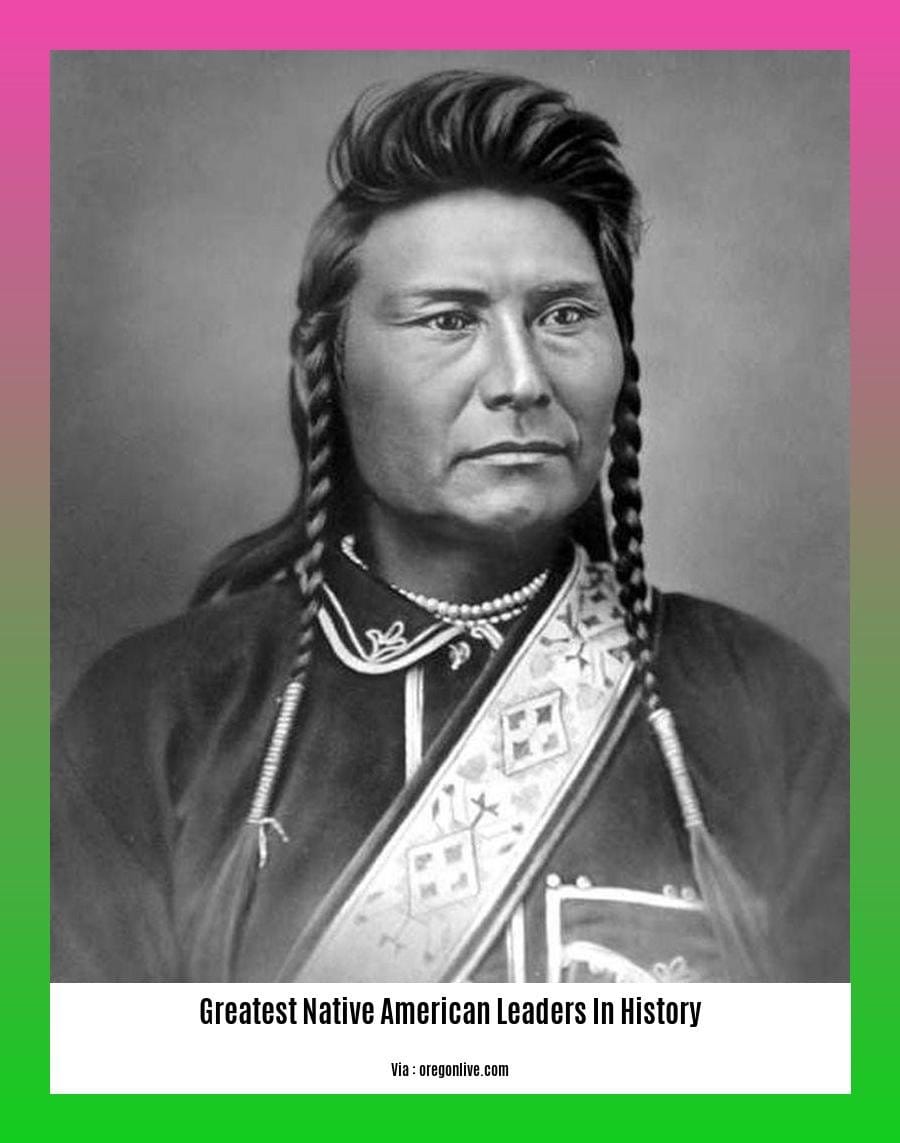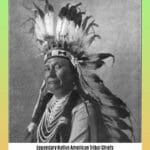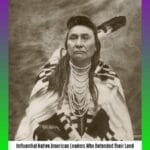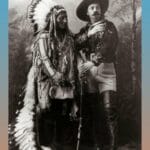In the annals of history, the names of the greatest Native American leaders echo as beacons of courage, resilience, and wisdom. From the hallowed halls of the Cherokee Nation to the vast prairies of the Great Plains, these extraordinary individuals shaped the destiny of their people, leaving an indelible mark on the tapestry of American history. In this article, we embark on a journey to explore the lives and accomplishments of these remarkable leaders, whose legacies continue to inspire and captivate generations.
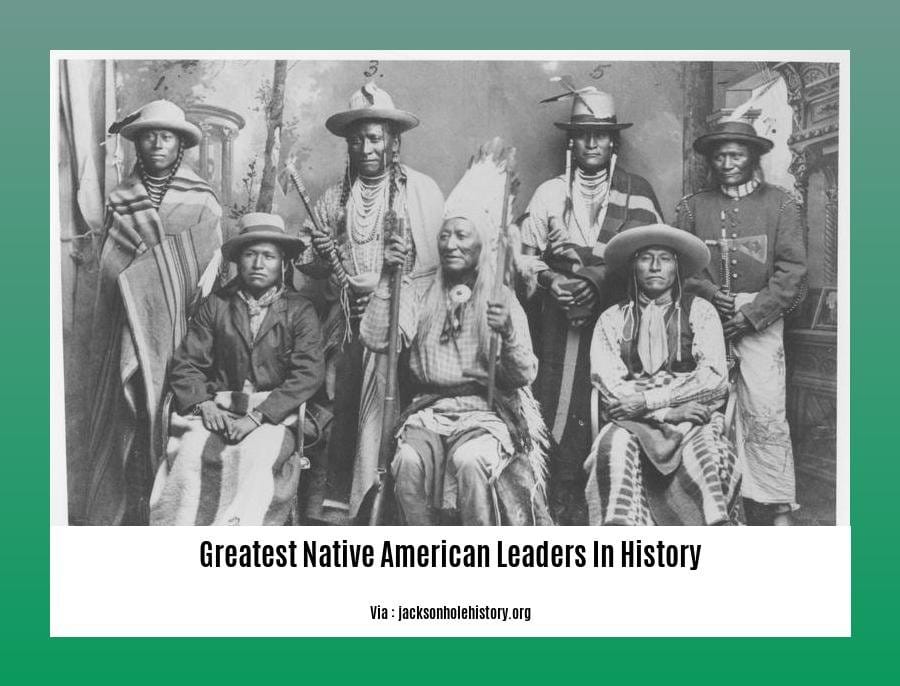
Key Takeaways:
- Powhatan’s 1682/3 Treaty of Shackamaxon established relationships with colonists.
- Tamanend’s Treaty of Shackamaxon promoted peace and unity among Native American tribes.
- Joseph Brant allied with the British during the French and Indian War.
- Sequoyah‘s Cherokee syllabary enabled written communication and literacy.
- Tecumseh spearheaded resistance against European expansionism.
- Sacagawea provided crucial guidance and interpretation for the Lewis and Clark Expedition.
- Red Cloud led the opposition to American government encroachment.
- Sitting Bull led the Lakota Sioux at the Battle of the Little Bighorn.
The Greatest Native American Leaders in History
Throughout time, great Native American leaders have emerged, shaping the destiny of their people and leaving an indelible mark on history. Their wisdom, courage, and resilience continue to inspire generations.
Powhatan: The Diplomat
As paramount chief of the Powhatan Confederacy, Powhatan skillfully negotiated with the early English settlers. His expertise in diplomacy helped maintain peace during the challenging first years of European contact.
Tamanend: The Peacemaker
Chief Tamanend of the Lenni-Lenape played a pivotal role in the Treaty of Shackamaxon. His vision for unity and cooperation paved the way for peaceful coexistence between Native Americans and European colonists.
Joseph Brant: The Warrior
Known as the “Grand Mohawk,” Brant allied with the British during the French and Indian War. His military prowess and strategic acumen earned him the respect of both friend and foe.
Sequoyah: The Innovator
A gifted inventor, Sequoyah created the Cherokee syllabary, revolutionizing written communication for his people. His ingenuity transformed their culture and preserved their language.
Tecumseh: The Unifier
A visionary leader of the Shawnee, Tecumseh sought to unite Native Americans against European expansion. His charisma and oratory skills inspired widespread resistance.
Sacagawea: The Guide
Sacagawea served as an invaluable guide and interpreter for the Lewis and Clark Expedition. Her knowledge and survival skills proved essential in navigating the uncharted wilderness.
Red Cloud: The Defender
As chief of the Oglala Lakota, Red Cloud fiercely resisted the encroachment of the US government on Native American lands. His leadership culminated in the signing of the Fort Laramie Treaty.
Sitting Bull: The Warrior Chief
Best known for his leadership at the Battle of the Little Bighorn, Sitting Bull was a revered spiritual leader and warrior. He dedicated his life to preserving the traditional ways of his people.
These greatest Native American leaders embody the resilience, adaptability, and courage of indigenous communities. Their legacies continue to shape the narrative of American history and remind us of the enduring spirit of their people.
Meet the famous native american chiefs and tribe leaders who left an enduring legacy with their wisdom and leadership. Learn about the legendary native american tribal chiefs who shaped the history of their people and protected their way of life. Discover the stories of influential native american leaders who defended their land and fought for the rights of their communities.
Tecumseh: Shawnee Warrior and Statesman
Key Takeaways:
- Tecumseh was a revered leader of the Shawnee nation.
- He was a skilled orator and statesman who advocated for intertribal unity.
- Tecumseh formed a Native American confederacy to resist the encroachment of American settlers.
- He fought alongside British forces in the War of 1812.
- Tecumseh’s legacy as a visionary leader and skilled warrior continues to inspire Native Americans today.
The Warrior
Tecumseh was born into the Shawnee tribe around 1768. From a young age, he showed great promise as a warrior and leader. He fought in the Battle of Wabash in 1791 and later in the Battle of Tippecanoe in 1811.
The Statesman
Tecumseh was not only a fierce warrior but also a gifted statesman. He believed that the Native American tribes needed to unite to preserve their lands and way of life. He traveled extensively, speaking to different tribes and urging them to join his confederacy.
The Warrior-Statesman
Tecumseh’s vision of a united Native American nation brought him into conflict with the United States government. In 1812, he joined forces with the British in the War of 1812. He hoped that by fighting alongside the British, he could gain support for his confederacy.
The Legacy
Tecumseh was killed in the Battle of the Thames in 1813. His death was a major blow to the Native American resistance movement. However, his legacy as a visionary leader and skilled warrior continues to inspire Native Americans today. He is remembered as one of the greatest Native American leaders in history.
Citation:
- Gale Group. (2000). Tecumseh. [Online]
Chief Joseph: Nez Perce Leader and Negotiator
Key Takeaways:
- Chief Joseph led the Nez Perce tribe in a heroic resistance against the US government’s forced relocation to a reservation.
- His military tactics and diplomatic efforts during the Nez Perce War earned him renown as a skilled strategist and negotiator.
- Chief Joseph’s famous surrender speech, delivered in 1877, expressed his pride in his people and his sorrow at the loss of their lands.
- He became a respected figure, admired for his courage, eloquence, and unwavering commitment to his people.
Leadership and Resistance
In 1877, when General Howard ordered the Nez Perce to move to a reservation, Chief Joseph refused. He knew that the land they had lived on for generations was rightfully theirs. With a small band of followers, he embarked on an extraordinary retreat across several states, pursued by the US Army.
Chief Joseph’s military acumen was evident in his skilled use of terrain and ambush tactics. He outsmarted the pursuing forces, leading them on a chase through treacherous mountains and deserts. His ability to negotiate and form alliances with other tribes along the way also aided their survival.
Surrender and Legacy
Despite their valiant efforts, the Nez Perce were eventually forced to surrender in October 1877. Chief Joseph’s famous surrender speech encapsulated the tragedy and resilience of his people. He spoke with both pride and sorrow, expressing his love for his land and his people, and his deep disappointment in the government’s betrayal.
After the war, Chief Joseph and the Nez Perce were relocated to Oklahoma. Despite the hardships they faced, he continued to fight for their rights. He became a respected figure, earning the admiration of both Native Americans and non-Natives for his unwavering spirit and dedication to his people.
Historical Significance
Chief Joseph’s legacy endures as a testament to the indomitable spirit of Native American leaders. His resistance to forced relocation, his military prowess, and his diplomatic efforts during the Nez Perce War remain sources of inspiration for those who fight for justice and the preservation of indigenous rights.
Citation:
- Wikipedia. “Chief Joseph.”
Sequoyah: Cherokee Inventor and Educator
Sequoyah, a prominent figure in Cherokee history, played a pivotal role in revolutionizing communication among his people. Born around 1770, he invented the Cherokee syllabary, a unique writing system that enabled the Cherokee to read and write in their own language.
Sequoyah’s invention had a profound impact on Cherokee society. Before the syllabary, the Cherokee relied on oral traditions and picture-writing to convey messages. Sequoyah’s system made it possible to record their history, culture, and laws in written form.
In addition to his contributions to literacy, Sequoyah was also an active participant in Cherokee politics. He served as a delegate to the Treaty of Chickasaw Council House in 1816, representing the interests of his people.
Key Takeaways:
- Birth and Death: Around 1770 – August 1843
- Known As: Sequoyah, George Gist, George Guess
- Tribe: Cherokee Nation
- Major Accomplishment: Inventor of the Cherokee syllabary (1821)
- Role: Never a principal chief but active in Cherokee politics
- Legacy: Revolutionized Cherokee communication and literacy
Most Relevant URL Source:
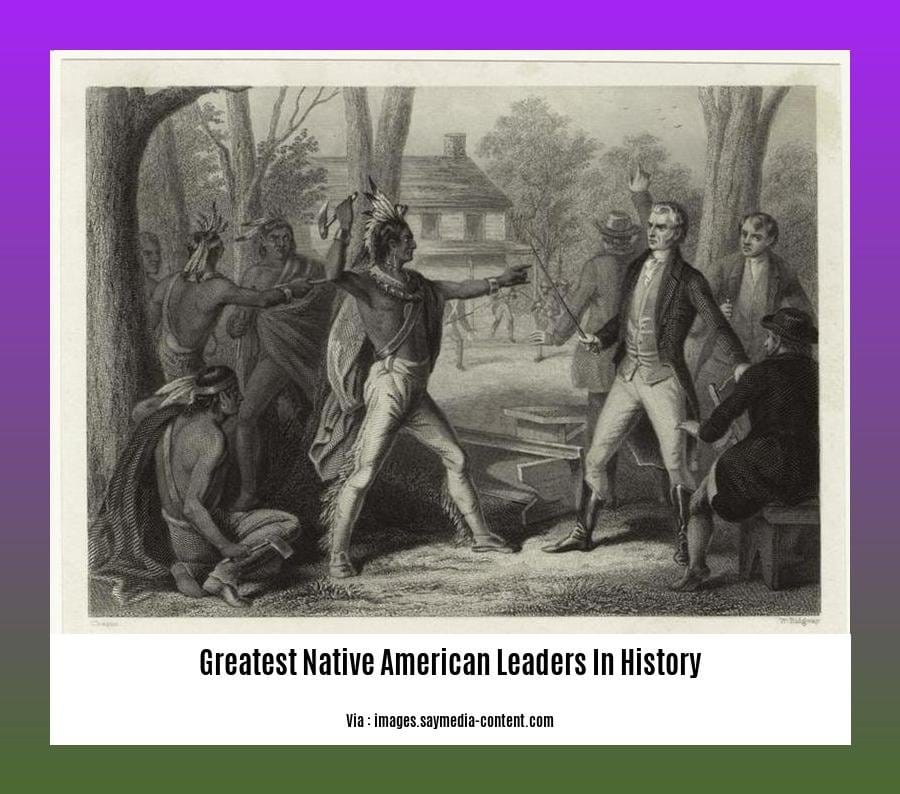
FAQ
Q1: Who was the most prominent Native American leader during the Treaty of Shackamaxon?
A1: Tamanend, the chief of the Lenni-Lenape, is attributed to have played a pivotal role during the Treaty of Shackamaxon.
Q2: Which Native American leader fought alongside the British in the French and Indian War?
A2: Joseph Brant, a Mohawk military leader, allied with the British during the French and Indian War.
Q3: Who was the Native American interpreter and guide for the Lewis and Clark Expedition?
A3: Sacagawea, a Native American woman from the Lemhi Shoshone tribe, served as an interpreter and guide for the Lewis and Clark Expedition.
Q4: Which Native American chief led a resistance against the US government during the 19th century?
A4: Red Cloud, a prominent Oglala Lakota chief, led a successful resistance against the US government’s encroachment on Native American lands in the Powder River Country.
Q5: Who created the Cherokee syllabary, revolutionizing literacy for the Cherokee people?
A5: Sequoyah, a Cherokee polymath and neographer, invented the Cherokee syllabary in the early 19th century, establishing a written language system for the Cherokee people.
